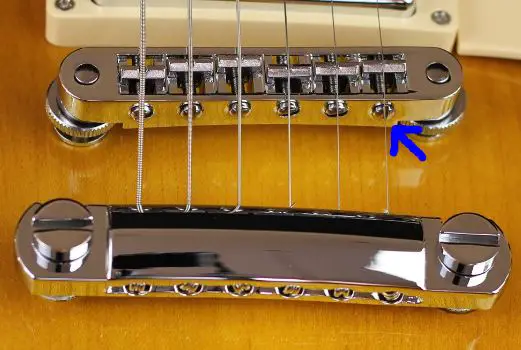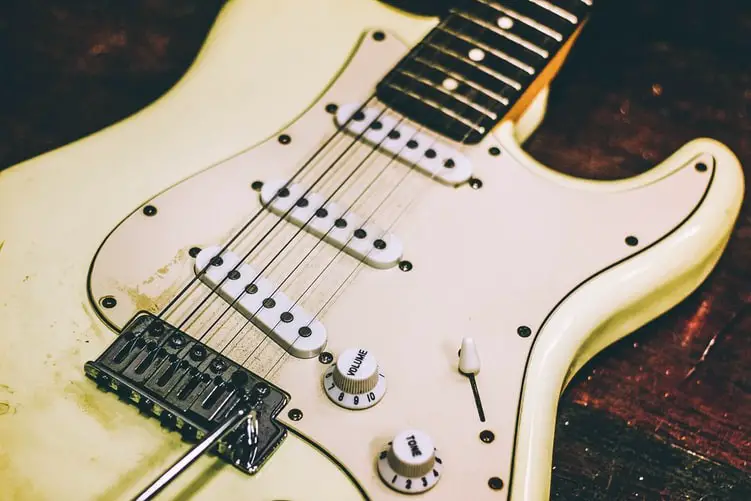Did you know setting guitar intonation will improve the accuracy of your tuning? This is important to understand because if you are experiencing dead frets then setting up the guitar intonation will solve your problem!
How to set up guitar intonation?
In this article, we will go over all these in greater detail… Let’s jump right in!
1. What is Guitar Intonation
Before starting the practical steps, let’s first go through the intonation theory and why it matters!
Have you ever experienced after tuning your guitar correctly some of the pitches across the fretboard seem a bit flat or sharp than they should?
I understand how annoying this is because your guitar will essentially never be in tune.
Luckily, calibrating the guitar intonation can fix those dead fret!
Because a guitar has a fretboard, each fret is fixed in length. This means no matter where you place your finger on a fret, the notes’ pitches are the same as the pitch of a note is determined by the fret’s position on the neck. This is different from other instruments such as a violin because it has no frets, if you play a note and feel that the note is not in tune, you can move your finger a little up or down to find the right one.
2. How Intonation Works
Every guitar has precise intonation. As the frets are fixed guitar players need to adjust the length of the string.
from the headstock to the nut of each string, called intonation correction.
The string length from the headstock to the bridge can be altered by adjusting the intonation screw on the bridge.
The longer the string, the greater the distance between the headstock and the bridge, and the shorter the string the smaller the distance is between the headstock and bridge.
Based on this principle, we can adjust the length of the string which will alter the tension of the individuals strings with conversely changes the pitch. We can keep doing this until the guitar sounds most accurately in tune.
3. Problems Caused – Why a Guitar Needs Intonating?
There are many reasons why a guitar will suddenly need to be intonated. The most common reason is the environment and but also changing the gauge of strings can cause problems.
Environmental factors
This is because the guitar’s construction is mainly made of wood which is very susceptible to environmental changes.
During the wintertime, there is more moisture in the air which will cause the wood to expand. Conversely, in the summer there is less moisture in the air causing the guitar wood to contract.
This movement will alter the pressure of the strings causing tension of the string to alter and thus could push the intonation offset to where to get dead notes.
Changing Gauge
Changing the gauge of your strings is also a common reason for the guitar pitch to alter causing problems with how it’s intonated.
This is because different gauges hold different tension to reach certain pitches.
- With a higher gauge (thicker strings) the tension needs to be higher
- With lower gauges, the tension needs to be lower to reach the desired pitch
It is recommended that electric and bass guitars have regular or cyclical intonation testing for the above reasons.
5. Tools needed to Intonate Your Guitar
Overall, the Tools needed are: Flat screwdriver or hex screwdriver, and a chromatic tuner are preferred for the best accuracy. Headstock tuners do not work as well.
Some common types of bridges on the market are:
- Tune-o-matic bridge: is the most common bridge type of Gibson Les Paul, SG. The back of the bridge has six flat screws; we use a flat screwdriver to adjust each string’s saddle.
- Fender telecaster/stratocaster bridge: Usually used on strat and tele, the back has 3 or 6 screws; use small a bake screwdriver to adjust.
- Gilbratar bridge: Use a hex screwdriver to adjust.
- Two-way ruffles (Ibanez Edge, Floyd Rose, etc.): Unlock the nut, release the strings. Use the hex screwdriver to open the screw. Use your hand to push the saddle down or up as you wish, then use the screwdriver to tighten the screw.
Overall, modifications can vary based on the guitar/bass bridge type.
5. Ensure BEST Accuracy
Before we begin to intonate we need to ensure our guitar is positioned in the BEST possible way.
So lets have a quick check!
- How long have you been using the current strings? And is the quality of the strings high or not? Needless to say, the quality and freshness of the strings have a massive impact on the sound. So be sure to change the strings whenever necessary, and use a good quality string!
- Are your pickups too high or too low? Pickups are magnets, so if set too high or too low, it will affect the strings made of metal.
- How do you set intonation? As warned above, you should set intonation in the playing position to give the highest accuracy.
- How accurate is your tuner? When tuning intonation, you should use high precision tuners.
- Playing position – One little notice for setting intonation is to do it in the playing position because it’s the familiar posture that you often use and because gravity also has a substantial impact on guitar setup accuracy.
This is because in some cases, after making adjustments, the intonation is still not correct. If this happens to you, then it is probably because you are not following the above.
5. How to check the Intonation
The first, thing you want to do in the step is to tune the guitar to your best ability. When you do the next steps make sure you do it in a room that is a constant temperature away from and radiators or heating systems.
You then want to go through the frets, starting with the low E string and every note from each fret against the tuner to make sure they are accurate. You want to start on the first fret and work your way down.
Remember to listen to every note that is being played and compare it against the chromatic tuner to make sure it matches.
6. Assess for Sharps or Flats
Because of the nature of the fretboard, if you have some notes which are off-pitch then they will usually be bundled together.
After tuning your guitar the top of the fretboard (near the nut) will usually hold the tuning whilst the bottom of the fretboard may be either sharp or flat.
You may also find that dead frets appear at the top of the fretboard against the higher strings.
Wherever the notes are not accurate you need to assess whether these notes are sharp or flat against the correct note.
- Sharp notes – when to pluck your string your tuner will show the note being sharp by appearing past the dial, which is to the right or the dial
- Flat notes – when you pluck your string your tuner will show the note being flat by appearing before the dial, which is left to the dial
Remember make sure you have a chromatic tuner to test against! to determine whether the inaccurate note is sharp or flat in pitch.
7. Locate the Intonation Screw

8. Adjusting the Saddle
A common technique people use to intonate is simply playing a harmonic on the 12th fret. If the 12th fret is flat or sharp then this will determine how the Saddle will want to be configured.
For example,
- If the 12th fret harmonic is sharp then you will move the saddle backwards towards the bridge. To do this you will turn the screw anti-clockwise to loosen the screw
- If the 12th fret harmonic is flat then you will move the saddle forwards towards the headstock. To do this you will turn the screw clockwise to tighten the screw.
Depending on how far the note is out will determine how much you want to turn the screw. But, usually, I will start doing full turns, then halves turn and quarter turns when it gets closer to the correct pitch.
9. Retune
Every time you have adjusted the intonation screw you will want to retune. This is because each turn you make will also affect the open string.
- So for the BEST accuracy, you will turn the intonation screw a full turn according to the 12th fret.
- Then retune that same string based off the open string reading.
- You will notice the reading is now close on the 12th fret. However, if it is still sharp or flat then repeat the process.
- As the tuning gets closer you can start to do half turns according to the reading from the 12th fret and retune.
- Then when your very close and out by a fraction do a quarter turn and retune.
Repeat this process until you finally get the pitch correct on both the open string and 12th fret harmonic.
Conclusion
Improper intonation causes some notes to become out of tune and it is something you definitely don’t want to happen while playing. Maybe it will just differ from the standard pitch a bit, but it is still something that needs fixing.
Setting intonation is usually part of a guitar setup, or you can adjust it yourself every time you change the strings or whenever you feel dissatisfied with your intonation.
- Check the intonation: Normally, the wrong intonation will appear in the higher frets. Compare the open string’s sound, then go to its fretted note on the 12th fret, each string respectively. These two notes are separated by an octave. Even though there is an octave difference, they must be the same note. If you feel the note in the 12th fret out of tune, that string should be set intonation.
- Adjust intonation: This is the step we need to use the tuner. Use the tuner to check specifically for intonation error. If the note on the 12th fret is too high, that string’s saddle needs to be moved far away from the headstock. If the 12th fret note is low, the saddle of that string needs to be moved closer to the headstock. Remember to use a screwdriver that matches your bridge’s saddles.
- Final tune: The impact on the strings will make your guitar out of tune. So, after adjusting the intonation, re-tune the string in the headstock. After tuning all the strings, take turns to test the intonation as in step 2.
luckily, it is not that hard to do and I hope this article helped your manage it!

